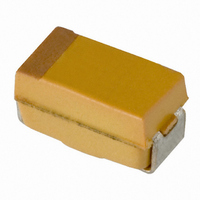TAJA225M006RNJ AVX Corporation, TAJA225M006RNJ Datasheet - Page 28

TAJA225M006RNJ
Manufacturer Part Number
TAJA225M006RNJ
Description
CAP TANTALUM 2.2UF 6.3V 20% SMD
Manufacturer
AVX Corporation
Series
TAJr
Type
Moldedr
Specifications of TAJA225M006RNJ
Capacitance
2.2µF
Voltage - Rated
6.3V
Tolerance
±20%
Esr (equivalent Series Resistance)
9.000 Ohm
Operating Temperature
-55°C ~ 125°C
Mounting Type
Surface Mount
Package / Case
1206 (3216 Metric)
Size / Dimension
0.126" L x 0.063" W (3.20mm x 1.60mm)
Height
0.063" (1.60mm)
Manufacturer Size Code
A
Features
General Purpose
Capacitance Tolerance
± 20%
Voltage Rating
6.3VDC
Capacitor Case Style
1206
No. Of Pins
2
Operating Temperature Range
-55°C To +125°C
Capacitor Mounting
SMD
Reel Quantity
2000
Rohs Compliant
Yes
Dimensions
1.6 mm W x 3.2 mm L
Mfr Case Code
A Case
Product
Tantalum Solid Standard Grade - Other Various
Termination Style
SMD/SMT
Lead Free Status / RoHS Status
Lead free / RoHS Compliant
Lead Spacing
-
Lead Free Status / Rohs Status
Compliant
Other names
478-3862-2
TAJA225M006R
TAJA225M006R
Available stocks
Company
Part Number
Manufacturer
Quantity
Price
Company:
Part Number:
TAJA225M006RNJ
Manufacturer:
AVX Corporation
Quantity:
34 524
Part Number:
TAJA225M006RNJ
Manufacturer:
AVX
Quantity:
20 000
Questions & Answers
56
Where
To compute the field voltage potential felt by the dielectric we
use the following logic.
Dielectric (Ta
No matter how pure the raw tantalum powder or the
precision of processing, there will always be impurity sites in
the dielectric. We attempt to stress these sites in the factory
with overvoltage surges, and elevated temperature burn in
so that components will fail in the factory and not in your
product. Unfortunately, within this large area of tantalum
pentoxide, impurity sites will exist in all capacitors.
To minimize the possibility of providing enough activation
energy for these impurity sites to turn from an amorphous
state to a crystalline state that will conduct energy, series
resistance and derating is recommended. By reducing the
electric field within the anode at these sites, the tantalum
capacitor has increased reliability. Tantalums differ from
other electrolytics in that charge transients are carried by
electronic conduction rather than absorption of ions.
C = ( (E) (E ° ) (A) ) / d
A = ( (C) (d) ) /( (E ° )(E) )
A = ( (22 x 10
A = 0.015 square meters (150 square centimeters)
C = Capacitance in farads
A = Dielectric (Electrode) Surface Area (m
d = Dielectric thickness (Space between dielectric) (m)
E = Dielectric constant (27 for tantalum)
E ° = Dielectric Constant relative to a vacuum
Dielectric formation potential = Formation Ratio x
(8.855 x 10
Electric Field Strength = Working Voltage / d
2
O
Formation Potential = 100 volts
5
) Thickness (d) is 1.7 x 10
-6
) (170 x 10
-12
Farads x m
-9
) ) / ( (8.85 x 10
d = 0.17 µ meters
-1
= 4 x 25
= (25 / 0.17 µ meters)
= 147 Kilovolts per
= 147 Megavolts
)
Working Voltage
millimeter
per meter
-9
Meters Per Volt
2
)
-12
) (27) )
Question: What negative transients can Solid Tantalum
Capacitors operate under?
Answer: The reverse voltage ratings are designed to cover
exceptional conditions of small level excursions into incorrect
polarity. The values quoted are not intended to cover contin-
uous reverse operation. The peak reverse voltage applied to
the capacitor must not exceed:
Question: I have read that manufacturers recommend a
series resistance of 0.1 ohm per working volt. You suggest
we use 1 ohm per volt in a low impedance circuit. Why?
Answer: We are talking about two very different sets of
circuit conditions for those recommendations. The 0.1 ohm
per volt recommendation is for steady-state conditions. This
level of resistance is used as a basis for the series resistance
variable in a 1% / 1000 hours 60% confidence level
reference. This is what steady-state life tests are based on.
The 1 ohm per volt is recommended for dynamic conditions
which include current in-rush applications such as inputs to
power supply circuits. In many power supply topologies
where the di/dt through the capacitor(s) is limited, (such
as most implementations of buck (current mode), forward
converter, and flyback), the requirement for series resistance
is decreased.
Question: How long is the shelf life for a tantalum capacitor?
Answer: Solid tantalum capacitors have no limitation on
shelf life. The dielectric is stable and no reformation is
required. The only factors that affect future performance of
the capacitors would be high humidity conditions and
extreme storage temperatures. Solderability of solder coated
surfaces may be affected by storage in excess of one year
under temperatures greater than 40°C or humidities greater
than 80% relative humidity. Terminations should be checked
for solderability in the event an oxidation develops on the
solder plating.
Question: Do you recommend the use of tantalum capacitors
on the input side of DC-DC converters?
Answer: No. Typically the input side of a converter is fed
from the voltage sources which are not regulated and are of
nominally low impedance. Examples would be Nickel-Metal-
Hydride batteries, Nickel-Cadmium batteries, etc., whose
internal resistance is typically in the low milliohm range.
10% of rated DC working voltage to a maximum
of 1 volt at 25°C.
3% of rated DC working voltage to a maximum of
0.5 volt at 85°C.
1% of category DC working voltage to a maximum
of 0.1 volt at 125°C.










